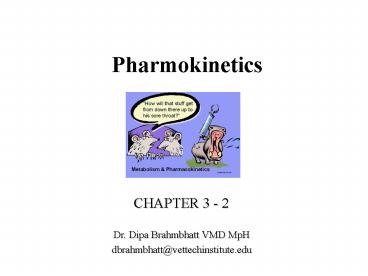Pharmokinetics PowerPoint PPT Presentation
1 / 30
Title: Pharmokinetics
1
Pharmokinetics
- CHAPTER 3 - 2
- Dr. Dipa Brahmbhatt VMD MpH
- dbrahmbhatt_at_vettechinstitute.edu
2
(No Transcript)
3
Drug Movement
- Pharmacokinetics includes the movement of
substances across cell membranes. - Basic mechanisms
- Passive diffusion
- Facilitated diffusion
- Active transport
- Pinocytosis/phagocytosis
4
Movement of Drug Molecules
This process is called passive diffusion No
cellular effort is needed to transport the
molecules (hence the process is passive)
Drug molecules move randomly from one point to
another
5
Passive Diffusion
Movement is random from areas of higher to areas
of lower concentration Eventually the drug
molecules are equally distributed
(equilibrium) Once equilibrium reached, molecules
still moving around but no net direction of
movement
High concentration in this area
6
Passive Diffusion
Cell Membrane
But drug molecules will only cross by passive
diffusion if they can dissolve in the membrane
Drug molecules may move from one side of a cell
membrane to another by passive diffusion
7
Passive Diffusion
- Movement of particles (atom, ion, molecules) from
an area of high concentration to an area of low
concentration - Rapid for small, lipophilic, nonionic particles
- The drug must dissolve and pass through in the
cell membrane - No energy / carrier
- Temperature depended
- Oxygen, carbondioxide
8
Passive Diffusion
- Rate of diffusion is dependent on
- Drug molecule size smaller gt faster
- Lipophilic dissolve in PL bilayer
- Temperature Low slower rate
- Thickness of membrane
9
Facilitated Diffusion
Cell Membrane
Cell Membrane
These drug molecules need a carrier to get across
the membrane
These molecules cant pass through the membrane
without help
10
Facilitated Diffusion
Cell
When the drug molecule encounters the carrier
protein, it carries it across
Membrane
Here is the carrier protein molecule in the
membrane
11
Facilitated Diffusion
Cell
When the drug molecule encounters the carrier
protein, it carries it across
Membrane
Here is the carrier protein molecule in the
membrane
12
Facilitated Diffusion
Cell
The carrier molecule then resets itself No
cellular energy is used to transport the molecule
across Only the concentration gradient moves the
molecules
Membrane
Here is the carrier protein molecule in the
membrane
13
Facilitated Diffusion
- Passive diffusion that uses a special carrier
molecule - Usually transport protein in PL bilayer
- Good for bigger molecules that are not lipid
soluble - No energy is needed for a facilitated diffusion
- Glucose and insulin
Revolving door analogy
14
Facilitated Diffusion
Passive Diffusion
15
Active Transport
Cell
The drug molecule encounters the carrier molecule
Membrane
The cell expends energy to PUMP the molecule
across the membrane to the other side
Involves a carrier molecule again
16
Active Transport
Cell
The drug molecule encounters the carrier molecule
The cell expends energy to PUMP the molecule
across the membrane to the other side
Membrane
Involves a carrier molecule again
17
Active Transport
Cell
Unlike diffusion, active transport is not
dependent upon concentration gradient
Membrane
Involves a carrier molecule again
All of the molecules can end up on this side
18
Active Transport
- Molecules move against the concentration gradient
- Carrier molecule
- Energy ATP
- Good for accumulation of drugs within a part of
the body - Electrolytes Na, K proton pump
- Creates pH gradient
- Move acidic/alkaline substance into urine
19
Active Transport
20
Carrier molecules
- Saturated carrier molecules are full
- Cant move any faster
- Transportation maximum t-max
- Drugs arrive at rate that exceeds t-max, drug jam
21
Pinocytosis/Phagocytosis
- Molecules are physically taken in or engulfed by
a cell - Pinocytosis (cell drinking) is engulfing liquid
particles (insulin) - Phagocytosis (cell eating) is engulfing solid
particles (nutrients) - Good for bigger molecules (proteins) or liquids
Active transport
22
Mechanisms of Drug Movement
23
Terminology
- Lipophilic drugs Fat loving (cell membrane
phospholipids e.g. intestinal mucosa) - Hydrophilic drugs Water loving, chemicals
dissolved in water IM hydrophilic faster
absorption - Ionized /- charge depended on pH. Mostly
hydrophilic form - Non-ionized No charge, neutral. Mostly
lipophilic form - Polarized charges at the end of the molecule
24
Phospholipid Bilayer
- Lipophilic in nature
- Nonpolarized/ nonionized molecules
25
DRUG MOVEMENT
- PHARMACOKINETICS is the physiological movement of
drugs. - 4 Steps therapeutic range
- Absorption
- Distribution
- Biotransformation
- (metabolism)
- Excretion
26
Drug Absorption
- Drug absorption is the movement of a drug from
the site of administration into the fluids of the
body that will carry it to its site(s) of action
(IV is directly in blood) - Drug factors include bioavailability, route of
administration, lipophilic/ hydrophilic, pH of
the environment, ion trapping, dissolution, first
pass effect, perfusion - Patient factors include the animals age, health,
metabolic rate, genetic factors, sex, and species
27
Bioavailability
- Bioavailability of drug administered
- that actually enters the systemic circulation
- IV/IA 100 available, bioavailability F 1
- lt 1 Drugs that are partially absorbed
- LOWER the bioavailability gt the LESS drug in
circulation gt LESS drug in the tissue - Exceptions where you dont want high
bioavailability local drugs, enteral drugs
28
Route of Administration
- IV (F1) stat gt IM gt SC gt PO
- Plasma (serum concentration) of drugs pg. 57
figure 3-6 - IV rapid high peak conc. for short period of
time. If toxic CRI e.g. digoxin bolus gt toxic
vomiting, arrhythmias
29
Lipophilic/ Hydrophilic
- SQ/ IM hydrophilic gt extracellular fluid (ECF) gt
capillaries - In GI lumen (outer) Deworming agents or
antibiotics for GI tract - PO lipophilic gt lumen GI tract
- SQ/IM slow release drug
30
References
- Romich, J.A. Pharmacology for Veterinary
Technicians, 2nd edition. 2010. - Bill, R.L. Clinical Pharmacology and Therapeutics
for the Veterinary Technician, 3rd edition. 2006. - Ahearn Gregory, Life on Earth, 5th edition, 2008.

